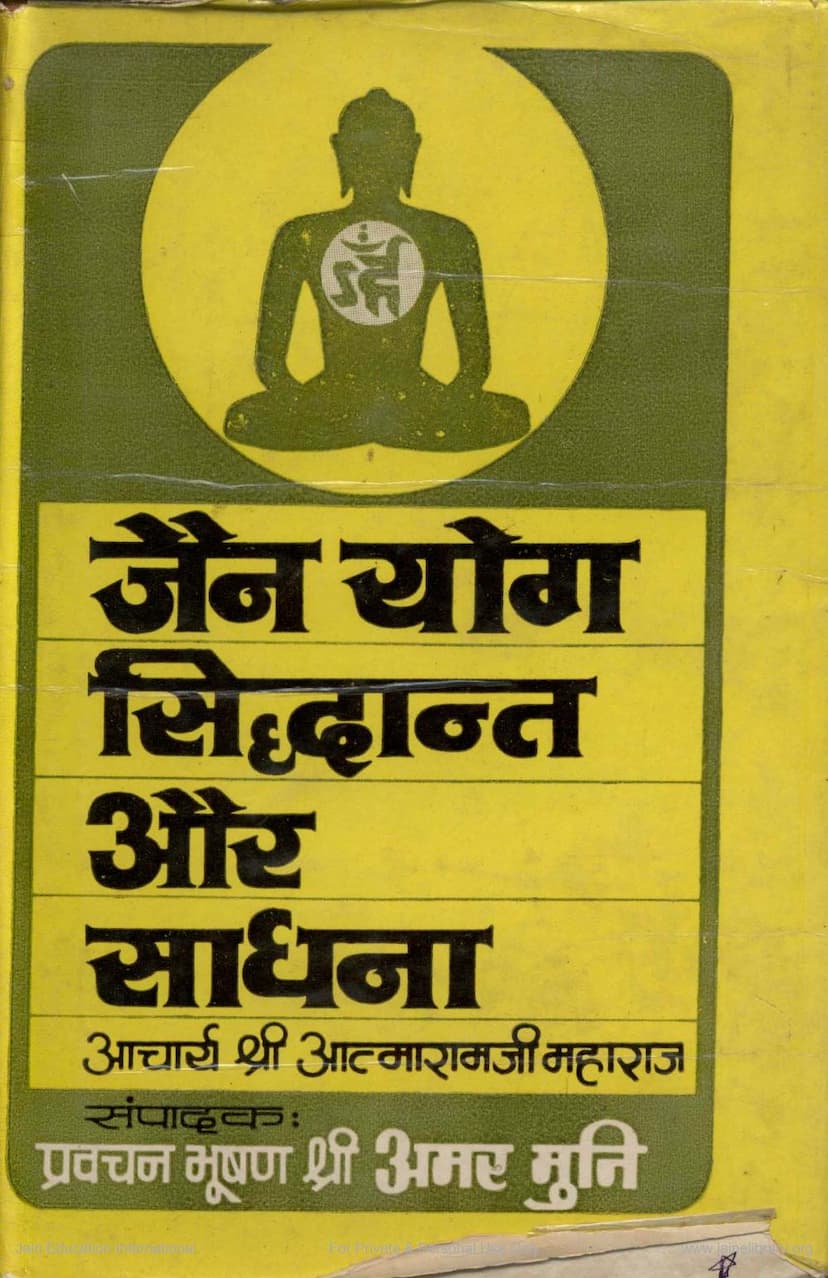Jain Yog Siddhanta Aur Sadhna
Added to library: September 2, 2025

Summary
Certainly, here's a comprehensive summary of the Jain text "Jain Yog Siddhanta aur Sadhna" by Acharya Sri Atmaramji Maharaj, based on the provided pages.
Book Title: Jain Yog Siddhanta aur Sadhna (Jain Yoga: Theory and Practice) Author: Acharya Sri Atmaramji Maharaj Publisher: Atma Gyanpith, Mansa Mandi (Punjab) Key Information:
- The book is a revised and enlarged edition of Acharya Sri Atmaramji Maharaj's earlier work, "Jain Agamo me Astang Yoga" (Eight Limbs of Yoga in Jain Agamas).
- It was published on the birth centenary of the esteemed Acharya Sri Atmaramji Maharaj.
- The primary editor is Sri Amar Muni, guided by Muni Sri Padam Chandji Maharaj 'Bhandari'.
Core Theme and Purpose:
The book aims to present Jain Yoga, its principles, and practices, demonstrating that Yoga, as a spiritual science and path to self-realization, is deeply rooted within the Jain tradition, even if the terminology or specific emphasis might differ from other Yoga lineages. It seeks to:
- Establish Yoga within Jainism: Counter the misconception that Yoga is solely a Hindu or Vedic practice, and highlight its integral role within Jain philosophy and practice as described in the Agamas.
- Elucidate Jain Yoga Principles: Explain the unique theoretical foundations and practical methods of Yoga as understood and practiced within Jainism.
- Promote Self-Realization: Guide readers towards achieving spiritual upliftment, inner peace, and ultimate liberation (Moksha) through the practice of Jain Yoga.
- Integrate Ancient Wisdom with Modern Understanding: Revise and expand upon the original work to incorporate contemporary scientific discoveries and research relevant to Yoga, making it accessible and applicable to a wider audience.
Key Concepts and Content Highlights:
The book delves deeply into various aspects of Yoga from a Jain perspective, covering a wide range of topics:
- Human Body as a Source of Infinite Power: The text emphasizes the untapped potential within the human body and mind, likening the body to a power house of immense energy. It explores the capabilities of the brain, the subtle intricacies of the body's energy centers (chakras), and the significance of marmasthanas (vital points).
- The Nature of Yoga: It defines Yoga as the union of mind, speech, and action with the soul, leading to spiritual energy. It contrasts scientific pursuit of power with spiritual pursuit of peace, asserting that Yoga is the path to peace.
- Jain Yoga's Unique Approach: While acknowledging common goals with other Yoga traditions, the book highlights Jain Yoga's emphasis on inner purification (Antah Shuddhi) over external rituals. It contrasts the focus on Hatha Yoga and Pranayama in some Hindu texts with Jain emphasis on Tapas (asceticism), Bhavana (meditative contemplation), and Dhyana (meditation) as the foundation of Yoga.
- The Astanga Yoga in Jain Agamas: A significant portion of the book focuses on how the eight limbs of Yoga (Yama, Niyama, Asana, Pranayama, Pratyahara, Dharana, Dhyana, Samadhi), as described in Patanjali's Yoga Sutras, are present in the Jain Agamas, albeit sometimes under different names or with a Jain philosophical interpretation. It compares and contrasts Jain Yoga with Patanjali Yoga, highlighting the specific Jain framework.
- The Five Types of Yoga (according to Acharya Haribhadra Suri):
- Adhyatma Yoga: Contemplation of the soul, emphasizing ethical conduct, meditation on the self, and following scriptural injunctions.
- Bhava Yoga: Continuous practice and contemplation of spiritual truths (Anuprēkṣā). It discusses the importance of the twelve Bhavanas (contemplations like Anitya, Arana, Samsara, etc.).
- Dhyana Yoga: Focuses on concentration and meditation, detailing various types like Dharana, meditation on deities, and various stages of inner absorption.
- Samata Yoga: Cultivating equanimity and detachment towards all objects and experiences, recognizing the illusory nature of worldly attachments.
- Vrtti Sankshaya Yoga: The cessation of all mental modifications and disturbances, leading to the state of pure consciousness.
- Subtle States of Consciousness and Energetic Practices: The book touches upon concepts like subtle bodies (Taijas Sharira), chakras, Kundalini (though acknowledging its less direct mention in early Jain texts compared to other traditions), and the importance of Prana (life force) and its control through various yogic techniques.
- Lābdhis (Supernatural Powers) and Siddhis: It discusses the extraordinary powers and attainments (Lābdhis or Siddhis) that can arise from dedicated Yoga practice, referencing their description in Jain, Vedic, and Buddhist traditions.
- The Significance of Faith (Shraddha) and Ethics (Sheel): The foundational role of unwavering faith in the spiritual path and the importance of ethical conduct (Sheel) as prescribed in Jainism are emphasized.
- Jain Yoga for Householders and Ascetics: The book outlines the progressive stages of spiritual practice for both lay practitioners (grihastha yogi) and ascetics (shramana), including the concept of 'Pratimas' (stages of spiritual discipline).
- The Importance of a Guru: It stresses the indispensable role of a qualified Guru in guiding the disciple through the intricate path of Yoga.
- The Power of Mantras: The text highlights the significance and power of mantras, particularly the Navkar Mantra, as a potent tool for spiritual development and achieving specific goals.
Key Contribution of the Book:
The book, by presenting Acharya Sri Atmaramji Maharaj's profound work in a revised and enlarged format, serves as a vital bridge connecting Jain philosophy with the universal science of Yoga. It democratizes this spiritual knowledge, making the profound principles of Jain Yoga accessible to the common reader, thereby fostering spiritual growth and well-being. The collaborative effort in editing and publishing underscores the commitment to disseminating this valuable wisdom.